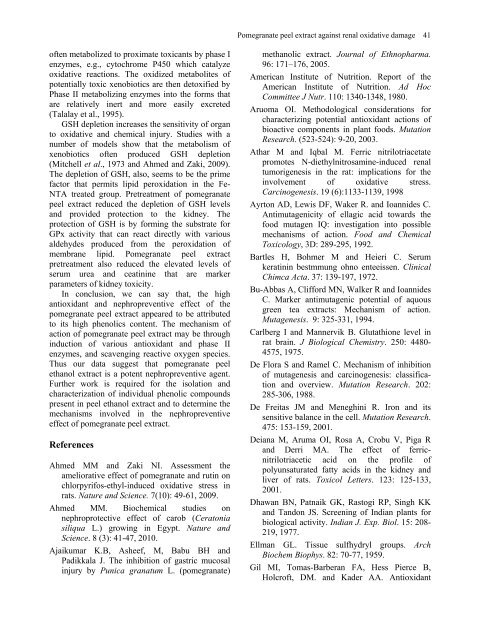Protective effect of pomegranate peel ethanol extract against ferric ...
Protective effect of pomegranate peel ethanol extract against ferric ...
Protective effect of pomegranate peel ethanol extract against ferric ...
You also want an ePaper? Increase the reach of your titles
YUMPU automatically turns print PDFs into web optimized ePapers that Google loves.
<strong>of</strong>ten metabolized to proximate toxicants by phase I<br />
enzymes, e.g., cytochrome P450 which catalyze<br />
oxidative reactions. The oxidized metabolites <strong>of</strong><br />
potentially toxic xenobiotics are then detoxified by<br />
Phase II metabolizing enzymes into the forms that<br />
are relatively inert and more easily excreted<br />
(Talalay et al., 1995).<br />
GSH depletion increases the sensitivity <strong>of</strong> organ<br />
to oxidative and chemical injury. Studies with a<br />
number <strong>of</strong> models show that the metabolism <strong>of</strong><br />
xenobiotics <strong>of</strong>ten produced GSH depletion<br />
(Mitchell et al., 1973 and Ahmed and Zaki, 2009).<br />
The depletion <strong>of</strong> GSH, also, seems to be the prime<br />
factor that permits lipid peroxidation in the Fe-<br />
NTA treated group. Pretreatment <strong>of</strong> <strong>pomegranate</strong><br />
<strong>peel</strong> <strong>extract</strong> reduced the depletion <strong>of</strong> GSH levels<br />
and provided protection to the kidney. The<br />
protection <strong>of</strong> GSH is by forming the substrate for<br />
GPx activity that can react directly with various<br />
aldehydes produced from the peroxidation <strong>of</strong><br />
membrane lipid. Pomegranate <strong>peel</strong> <strong>extract</strong><br />
pretreatment also reduced the elevated levels <strong>of</strong><br />
serum urea and ceatinine that are marker<br />
parameters <strong>of</strong> kidney toxicity.<br />
In conclusion, we can say that, the high<br />
antioxidant and nephropreventive <strong>effect</strong> <strong>of</strong> the<br />
<strong>pomegranate</strong> <strong>peel</strong> <strong>extract</strong> appeared to be attributed<br />
to its high phenolics content. The mechanism <strong>of</strong><br />
action <strong>of</strong> <strong>pomegranate</strong> <strong>peel</strong> <strong>extract</strong> may be through<br />
induction <strong>of</strong> various antioxidant and phase II<br />
enzymes, and scavenging reactive oxygen species.<br />
Thus our data suggest that <strong>pomegranate</strong> <strong>peel</strong><br />
<strong>ethanol</strong> <strong>extract</strong> is a potent nephropreventive agent.<br />
Further work is required for the isolation and<br />
characterization <strong>of</strong> individual phenolic compounds<br />
present in <strong>peel</strong> <strong>ethanol</strong> <strong>extract</strong> and to determine the<br />
mechanisms involved in the nephropreventive<br />
<strong>effect</strong> <strong>of</strong> <strong>pomegranate</strong> <strong>peel</strong> <strong>extract</strong>.<br />
References<br />
Ahmed MM and Zaki NI. Assessment the<br />
ameliorative <strong>effect</strong> <strong>of</strong> <strong>pomegranate</strong> and rutin on<br />
chlorpyrifos-ethyl-induced oxidative stress in<br />
rats. Nature and Science. 7(10): 49-61, 2009.<br />
Ahmed MM. Biochemical studies on<br />
nephroprotective <strong>effect</strong> <strong>of</strong> carob (Ceratonia<br />
siliqua L.) growing in Egypt. Nature and<br />
Science. 8 (3): 41-47, 2010.<br />
Ajaikumar K.B, Asheef, M, Babu BH and<br />
Padikkala J. The inhibition <strong>of</strong> gastric mucosal<br />
injury by Punica granatum L. (<strong>pomegranate</strong>)<br />
Pomegranate <strong>peel</strong> <strong>extract</strong> <strong>against</strong> renal oxidative damage 41<br />
m<strong>ethanol</strong>ic <strong>extract</strong>. Journal <strong>of</strong> Ethnopharma.<br />
96: 171–176, 2005.<br />
American Institute <strong>of</strong> Nutrition. Report <strong>of</strong> the<br />
American Institute <strong>of</strong> Nutrition. Ad Hoc<br />
Committee J Nutr. 110: 1340-1348, 1980.<br />
Aruoma OI. Methodological considerations for<br />
characterizing potential antioxidant actions <strong>of</strong><br />
bioactive components in plant foods. Mutation<br />
Research. (523-524): 9-20, 2003.<br />
Athar M and Iqbal M. Ferric nitrilotriacetate<br />
promotes N-diethylnitrosamine-induced renal<br />
tumorigenesis in the rat: implications for the<br />
involvement <strong>of</strong> oxidative stress.<br />
Carcinogenesis. 19 (6):1133-1139, 1998<br />
Ayrton AD, Lewis DF, Waker R. and Ioannides C.<br />
Antimutagenicity <strong>of</strong> ellagic acid towards the<br />
food mutagen IQ: investigation into possible<br />
mechanisms <strong>of</strong> action. Food and Chemical<br />
Toxicology, 3D: 289-295, 1992.<br />
Bartles H, Bohmer M and Heieri C. Serum<br />
keratinin bestmmung ohno enteeissen. Clinical<br />
Chimca Acta. 37: 139-197, 1972.<br />
Bu-Abbas A, Clifford MN, Walker R and Ioannides<br />
C. Marker antimutagenic potential <strong>of</strong> aquous<br />
green tea <strong>extract</strong>s: Mechanism <strong>of</strong> action.<br />
Mutagenesis. 9: 325-331, 1994.<br />
Carlberg I and Mannervik B. Glutathione level in<br />
rat brain. J Biological Chemistry. 250: 4480-<br />
4575, 1975.<br />
De Flora S and Ramel C. Mechanism <strong>of</strong> inhibition<br />
<strong>of</strong> mutagenesis and carcinogenesis: classification<br />
and overview. Mutation Research. 202:<br />
285-306, 1988.<br />
De Freitas JM and Meneghini R. Iron and its<br />
sensitive balance in the cell. Mutation Research.<br />
475: 153-159, 2001.<br />
Deiana M, Aruma OI, Rosa A, Crobu V, Piga R<br />
and Derri MA. The <strong>effect</strong> <strong>of</strong> <strong>ferric</strong>nitrilotriacetic<br />
acid on the pr<strong>of</strong>ile <strong>of</strong><br />
polyunsaturated fatty acids in the kidney and<br />
liver <strong>of</strong> rats. Toxicol Letters. 123: 125-133,<br />
2001.<br />
Dhawan BN, Patnaik GK, Rastogi RP, Singh KK<br />
and Tandon JS. Screening <strong>of</strong> Indian plants for<br />
biological activity. Indian J. Exp. Biol. 15: 208-<br />
219, 1977.<br />
Ellman GL. Tissue sulfhydryl groups. Arch<br />
Biochem Biophys. 82: 70-77, 1959.<br />
Gil MI, Tomas-Barberan FA, Hess Pierce B,<br />
Holcr<strong>of</strong>t, DM. and Kader AA. Antioxidant
















